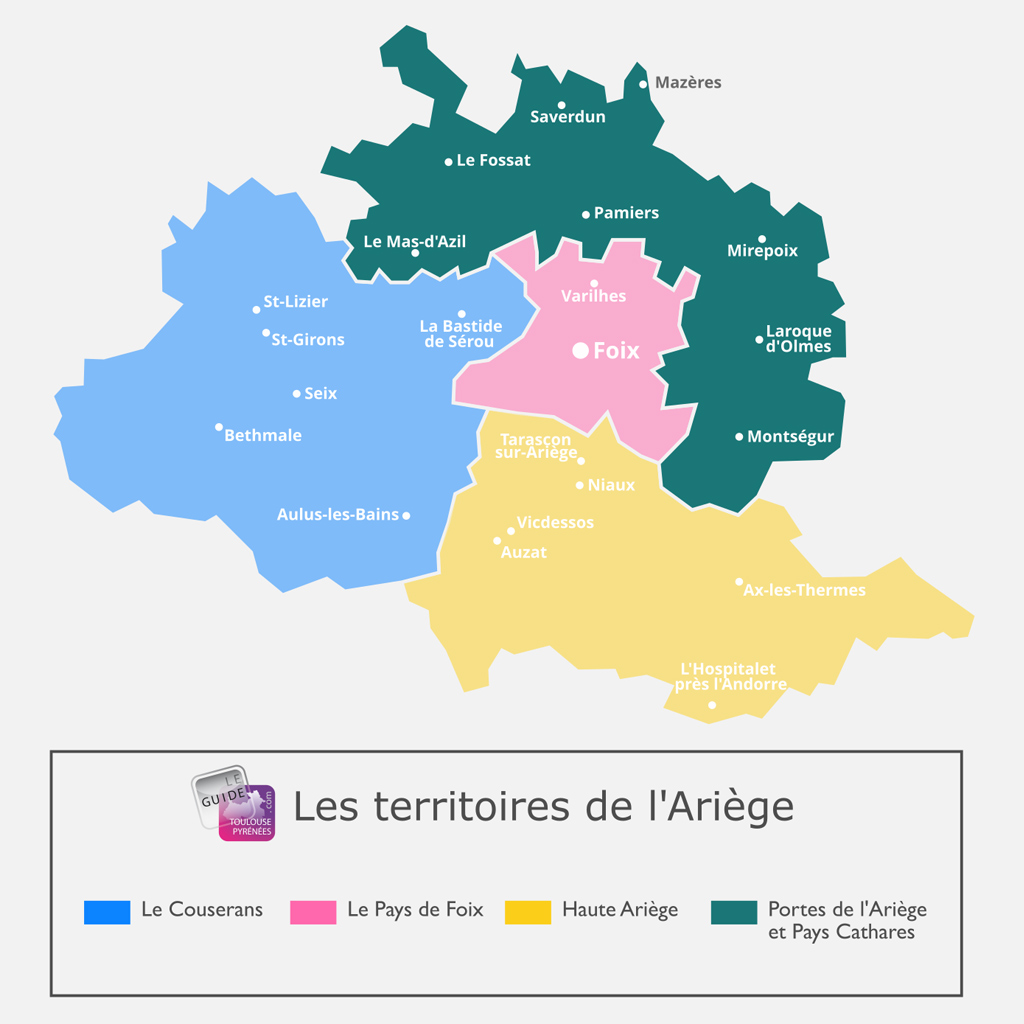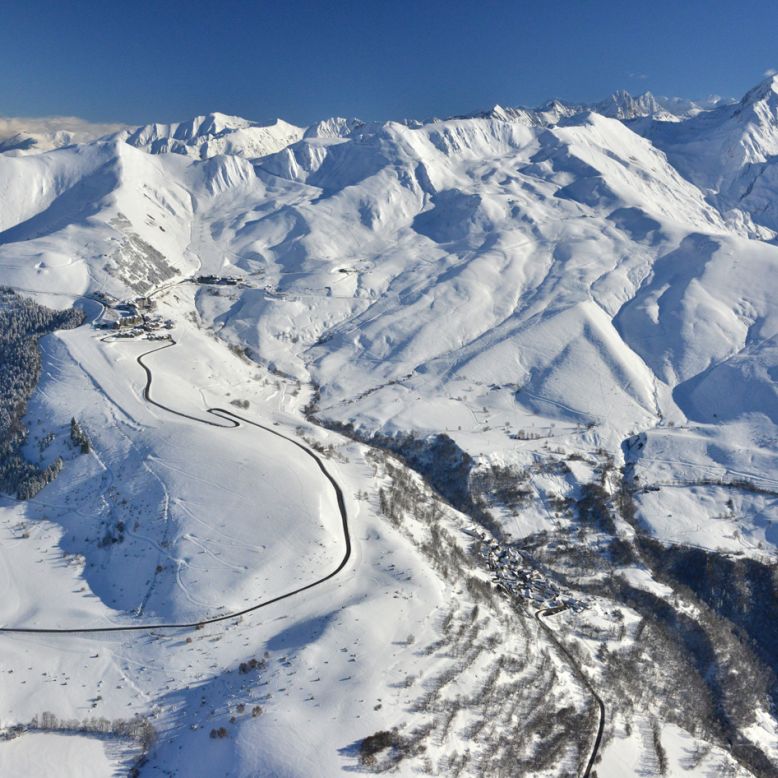- Home page
- Tourism
- Discover
- Visit Toulouse region and the French Pyrénées
- Ariège - Porte de l'Ariège et Cathare's country
- Visit Toulouse region and the French Pyrénées
- Discover
- Tourism
Ariège - Porte de l'Ariège et Cathare's country
Between Toulouse and the Pyrenees Mountains, there are the Portes de l'Ariège, a terrirory in the Pyrénées Piedmont, a land of plains and hills with milder temperatures than the rest of the department. It is a prosperous territory thanks to its aeronautical industry, chemistry and metallurgy. The Arize and Lèze Valleys, around the Mas d'Azil have a rich historic heritage and especially prehistoric and geological. Towards the East, the Pays d'Olmes is close to the Aude, its calcareous relief and its remote location allowed the installation of beautiful Cathar Castles, refugees for those hunted by the Catholic Church.

Discover this territory full of history and mysteries, rich in events and sites to visit. All types of landscapes are waiting for you, each day can be a different atmosphere. The North and East of the department will surprise you!
Le Mas d'Azil
The village of Mas d’Azil is an ancient bastide, important place of the Protestantism. In 1625, 14,000 soldiers of Richelieu besieged the citywhich resisted five weeksthenthe blockade was lifted.
The village houses a cave, one of the most important prehistoric sites, 420 meters ofa departmental road runs through the cave. This enormous natural gallery was inhabited 32,000 years ago and was later used as a refuge for the Cathars and Protestants. It gave its name to the Azilian civilisation. Today, the development of one of the main sites of the region, allows people to visit this listed historic monument. The artefacts of the excavation of the cave, some Palaeolithic Art pieces, are exhibited at the Prehistoric Museum, located in the village.
Other curiosities to see in the commune: 11 dolmens scattered in the surrounding area, which date from the Bronze Age (1,800 to 700 BC) of which three are easily accessible for visit: The Dolmen de Cap del Pouech, Brillaud andCouminge.
Guide Toulouse Pyrénées’ Best Tips:
- In the surrounding, the picturesque village of Carla-Bayle is a medieval bastide, built during the 12th century, located on rocky ridge, offering a beautiful panorama on the surrounding landscapes. It is also the land of the philosopher of the enlightenment Pierre Bayle (1647 – 1706),the house where he was born is now a museum. Have a walk on the fortifications for a panoramic view!
- The Terrasses du Souribet walk, brings you to lovely dry stone cabins, which are a legacy of the pastoral activity of the region.
- If you are a pilgrim on to road of Saint-Jacques, a stopover is available: The Jacquaire Halt of Mas d'Azil.
- The market of the commune takes place on Thursday morning.
- If the kids have had enough of the Cathars and hiking? Go to Xploria, a dinosaur parkwith fun and educational activities so that everybody can have fun during the holidays.
- An unusual place to visit: along the D119, the Chemin de Croix de la Chapelle de Reynaude (the way of sorrows of the Reynaude chapel). Behind the church, 14 small chapels are placed along a path that goes to an ordeal.
Saverdun
Saverdun is a town located at the doors of the Ariège, which suffered the crusade of the Albigeois, who hunted the Cathars in this region, and the Reformation.In town, only the vestiges of the castle remain, the rest being destroyed by the many religious conflicts... Also discover the Catholic Church and the Protestant Temple. Saverdun is the chief-town of the district, which has developed an important agricultural economy, as much for farming than culture. This goes hand in hand with the development of a rural tourism, opening the door of the producers and farms to the travellers happy to discover the local products. The Hers and Ariège rivers flow close to the townand favourable to many sport and leisure activities.
Guide Toulouse Pyrénées’ Best Tips:
- To relax during summer, a pleasant nautical centre is available in the former quarry. The waters are clear and many activities are available during the season, including electrical Jet Ski for children (from 6 years old) made in Mazère, just next door.
- The market of Saverdun takes place on Friday morning.
Mazères
The Bastide of Mazères is located at the far North department. At the end of the 17th century, it is an important Protestant citadel, which economy is turned towards agriculture and in particular the Pastel. Isatis Tinctoria is a herbaceous plant which leaves produce a blue dye through a process of air oxydation and chemical reaction. It results in some pigments (blue... pastel!). During World War 2, a disused premise of in town was used to detain Spanish anarchists. Have a walk inMazères, visit the church, look at the surrounding half-timbered houses as well as the market hall housing the market on Thursday. The Hôtel Pastelier Ardouin, surrounded by garden, houses two museums: one dedicated to the history of the town and the other to the "Barbars in South Gaule ".
Guide Toulouse Pyrénées’ Best Tips:
- Less than 4km from the town centre, going towards Villefranche-de-Lauragais, are two orientation tables, with a beautiful viewpoint over the bastide and the Pyrénées.
- The Domaine des Oiseaux is a beautiful ornithological park, to discover the flora and the fauna of the region. Follow the signed trails to know more on the terrestrial inhabitants and the birds of the reserve. Just next door, the Museum of the Domaine des Oiseaux exhibits a tool and rural machinery collection.
- Go to see the remnants of the bridge on the Hers River in Mazères, which had been built 9 times since 1259, the last time was in 1804, it was then destroyed by a flood in 1875 and never built again... the cursed bridge?
- A medieval fair takes place in Mazères in August.
- Do you fancy agyrocopter ride (Microlight in shape of a helicopter)? To see the beautiful landscapes of the region from the sky, go tothe Ailes de Terraqueuse, and meetThibault.
Pamiers
Pamiers is the second sub-prefecture (administrative centre) of the department (with Saint-Girons, the Prefecture (main administrative centre) beingFoix), but it is the most populated town the in the Ariège. Despite the turmoil of the Crusades against the Cathar heresy, Pamiers shines since the beginning of the 14th century thanks to its rank of religious capital. Many convents from different orders settled. During the 16th century, the town was paralysed by the plague for three years. During the same period, the Religious Wars affected the town and its inhabitants. The weaken town found a new economicboomwith the development of the metallurgy during the 14th century. In Pamiers, visit the Saint-Antonin Cathedral, dating from the 17th century, the Notre-Dame-du-Camp Church, its large carillon and its organ. Le Carmel, a convent founded in 1648, with a Tower, a Chapel, the Cordeliers Tower, the Cailloux Abbey (listed Monument Historic) and the Monnaie Tower should also be visited.
Guide Toulouse Pyrénées’ Best Tips:
- Would you like to see the town from the sky? Go skydiving with Sky Dive Pamiers!
- The Festival de Musiques au pays de Gabriel Fauré (Music Festival in Gabriel Fauré’s land) with classical music concerts and piano, takes place during several months each year in Pamiers.
Mirepoix
This is Cathar country. Totally destroyed by a flood in 1289, the bastide was entirely rebuilt on another bank. The town has retained its medieval character. Its central square, Place des Couverts, with its half-timbered houses on wooden galleries, is an invitation to discover.
A short distance from Mirepoix, Camon is a stronghold built around its former abbey by Philippe de Levis in the 16th century. The village has the particularity of being surrounded by a hundred rosebushes. Outside the village, you can also discover more than a hundred dry stone huts. It was the family of the same Philippe de Levis who built the Château de Lagarde, which became the "Little Versailles" of which only the remains remain.
Montségur
It is a village of the low and medium mountains and full of history. Many peaks form a beautiful scene around the commune: The Pic de Soularac and Pic de Saint-Barthélémy, amongst other. A stream, the Lasset, flows through the bottom of the valley. Montségur is famous for its castle, installedon the "pog" (high part) of a rocky promontory. The occupation of the place is ancient (the existence of the castle is thought to be prior to the Cathars) and the heretics settled in during the 13th century, escaping the Catholic persecution chasing them and depriving them of their lands. The last Cathar strong hold, Montségur resisted, and fell after being besieged for nearly one-year in 1244. The inhabitants were sent to the pyre (more than 200 people were burn alive)... The castle was rebuilt later. Montségur is also recognized for its Prehistoric and Roman occupation, in particular the Grotte de Las Mortswhere archaeological furniture as well as a child grave, have been found.
Guide Toulouse Pyrénées’ Best Tips:
- The Nazis ransacked the castle from top to bottom during WW2, convinced they would find some traces of the Holy Grail...
- Next to the castleis an Historic and Archaeological Museum, to learn more about the Cathars.
- Close to the village, the Regional Nature Reserve of the Saint-Barthélemy Massif is the first one in Ariège, this listing confirms the exceptional quality of the natural local heritageand the present biodiversity.
La Maison de la Montagne
La Maison de la Montagne
La Maison de la Montagne, a top-of-the-range 4-star gîte in Montferrier La Maison de la Montagne is the second ...
4,2 km - Montferrier
Le Presbytère de Montferrier
Le Presbytère de Montferrier
Le presbytère de Montferrier, a gîte with a whole history in Ariège In love with his region and in particular ...
4,2 km - Montferrier
La Ferme des Baillards
La Ferme des Baillards
La Ferme des Baillards, a proposal for an unusual night's stay in Ariège Experience an unforgettable moment in the ...
7,9 km - Bélesta
Also to discover in this territory...
- At 4km to the north of Mas d'Azil: theSabarat Observatory organise public evenings on astronomy.
- At 13km from Mas d'Azil, the village ofPaihèsand its castle (which cannot be visited... yet! But which is beautiful to admire from far)
- A 10km to the northwest from Mas d'Azilis the Ferme des Moulis, where two passionate peoplefarm 140 angora goats to make Mohair: a fibre which offers a soft and light warmth: guided toursavailable. The owners also offer tourist accommodation.
- At 12km to the west of Carla Bayle: the lovely village ofDomazan-sur-Arize.
- Juste above Domazan-sur-Arize: the village of the Bastide de Besplas, with its charming square, the churchand its imposing wall bell-fry.
- At 19km from Mirepoix, to the northwestinLapenne: the surprisingBuffalos Farm, with free ranging buffalos, bucks, yacks and deersin a 70ha park. Come and have a great visit, sitting in a tractor with a trailer!! The children will love it!!
- Few steps away from the Buffalos Farm, also inLapenne, the Parc aux Bambous, listed “Remarkable Gardens of France”, to know everything on this incredible grass.A nurseryoffers super specimens for sale.
- In the south of the territory,close to Roquefort-les-Cascades: the Roquefixade Castle, a Cathar Castle whose ruins are listed Historic Monuments.
- In the Southeast of Mirepoix: The fortified village of Camonand the Mac de Montbel, just below.
- The surprising Textile and horn museum in Lavelanet.









